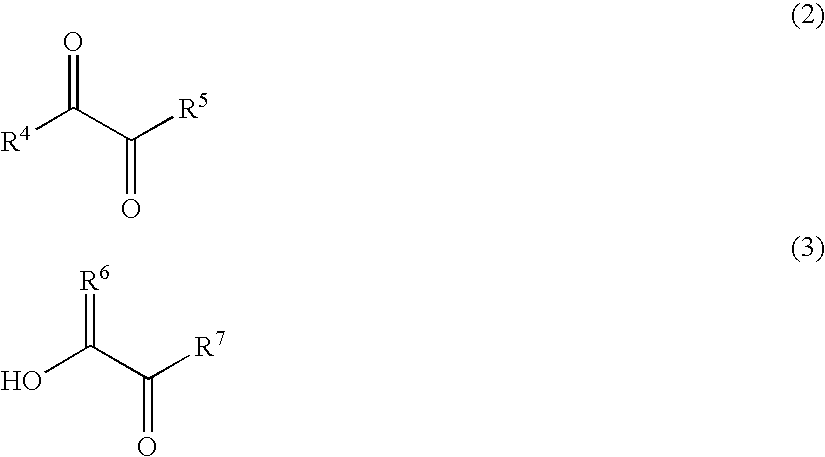Malodor reducing composition, fragrance composition and product comprising the same
a technology of fragrance composition and composition, applied in the direction of detergent compounding agent, application, soap ingredients, etc., can solve the problem of not being completely satisfactory, and achieve the effect of simple and inexpensiv
- Summary
- Abstract
- Description
- Claims
- Application Information
AI Technical Summary
Benefits of technology
Problems solved by technology
Method used
Image
Examples
reference example 1
[0154]The malodor reducing capability of individual ingredients, namely 1,2-diketones and phenylglycidates of the invention is tested according to the following procedure.
Procedure
[0155]Add into a 20 cm3 headspace vial:[0156]100 μg of a 1% (wt / wt) solution of 1-hexylamine in dipropylene glycol;[0157]7.0 g of demineralised water;[0158]20 μl of 1,2-diketone or phenylglycidate;[0159]0.2 g of Emulgin L® (Cognis)[0160]Mix for 10 minutes at room temperature;[0161]Equilibrate for 50 minutes at 35° C.;[0162]Measure the headspace concentration of the hexylamine by solid phase microextraction (SPME) on a polydimethylsilicone divinylbenzene fibre (ex Supelco);[0163]Sample the vapour for 5 minutes at 35° C. then desorb onto a 30 m HP-5MS GC column at 265° C. for 1 minute.
[0164]The headspace concentration is calculated by comparison with a standard having no malodor reducing fragrance and is reported as the reduction in area percent of the GCMS signal for hexylamine. The results are given in Tab...
reference example 2
[0165]This reference example shows the effect of increasing the concentration of a typical diketone β-thujaplicine within fragrance A of table 4 on the malodor compared with the fragrance itself. The procedure is similar to that described in reference example 1 above except that a 50 μl aliquot of fragrance is used instead of the 20 μl aliquot of the 1,2-diketone or phenylglycidate in reference example 1. The test fragrance consists partly of fragrance A and partly of a 1,2-diketone, phenylglycidate or a mixture thereof, with part of the diethyl phthalate within fragrance A being replaced by the malodor reducing compounds of the invention. Malodor reduction is measured as the concentration of hexylamine in the vapour phase compared with a control sample which contains fragrance A without any malodor reducing ingredients of the invention.
TABLE 4Formulation of Fragrance AIngredientCAS No%Allyl cyclohexyl propionate2705-87-50.2Allyl heptoate142-19-80.3Armoise oil0.4Benzyl acetate140-11...
reference example 3
[0167]Reference example 3 repeats reference example 2 but with ethyl 3-phenylglicidate instead of β-thujaplicine. The results in table 6 show a definite trend in response to increasing the phenylglycidate concentration.
TABLE 6Malodor reduction due to dosage of Ethyl 3-phenylglicidateEthyl 3-phenylglicidate in Fragrance A**Malodor Reduction (%)1%315%3910%54**Ethyl 3-phenylglicidate replaces the equivalent weight of Diethyl Phthalate in fragrance A as described in reference example 2.
PUM
| Property | Measurement | Unit |
|---|---|---|
| weight ratio | aaaaa | aaaaa |
| molecular weights | aaaaa | aaaaa |
| molecular weights | aaaaa | aaaaa |
Abstract
Description
Claims
Application Information
 Login to View More
Login to View More - R&D
- Intellectual Property
- Life Sciences
- Materials
- Tech Scout
- Unparalleled Data Quality
- Higher Quality Content
- 60% Fewer Hallucinations
Browse by: Latest US Patents, China's latest patents, Technical Efficacy Thesaurus, Application Domain, Technology Topic, Popular Technical Reports.
© 2025 PatSnap. All rights reserved.Legal|Privacy policy|Modern Slavery Act Transparency Statement|Sitemap|About US| Contact US: help@patsnap.com



